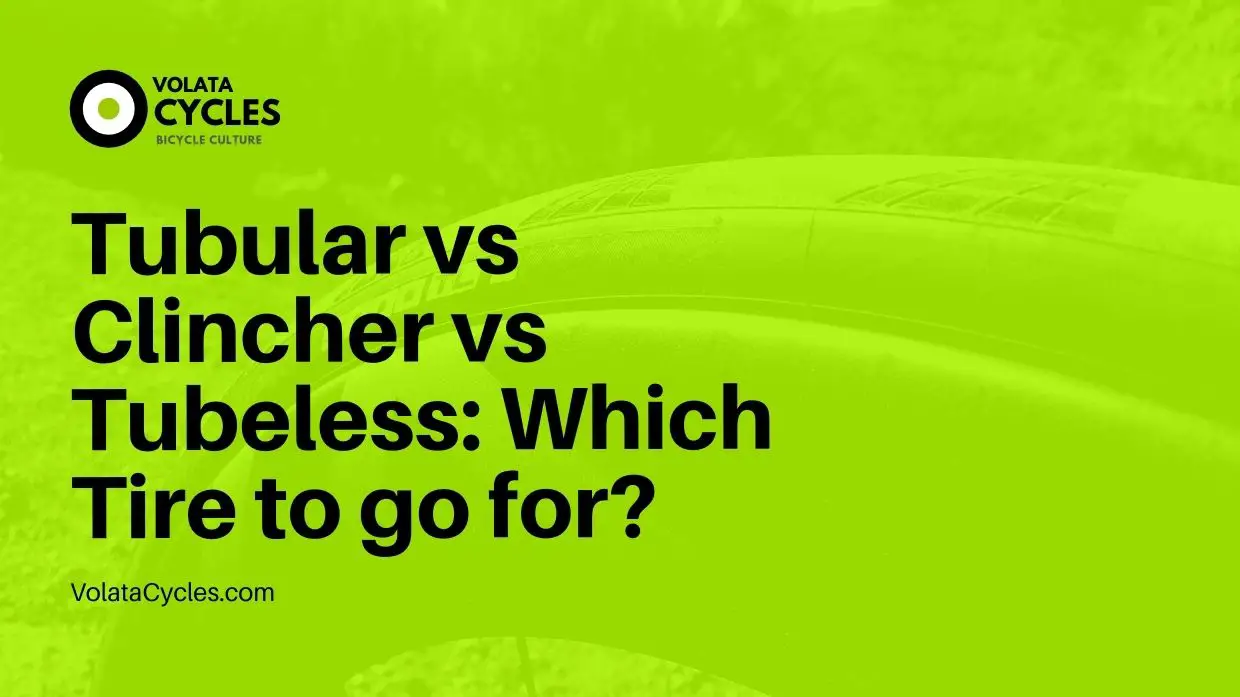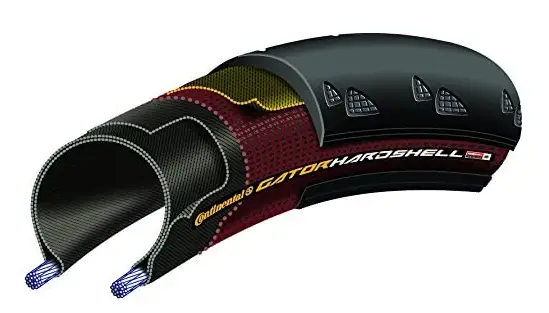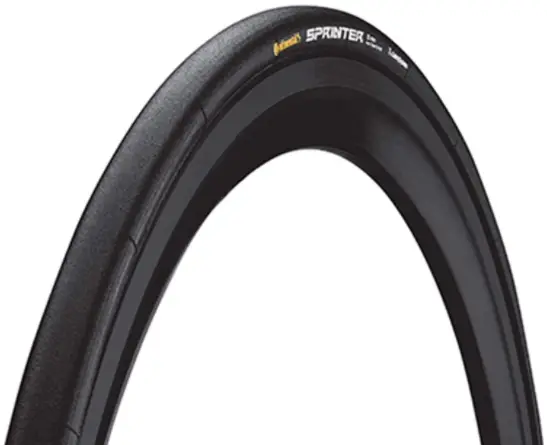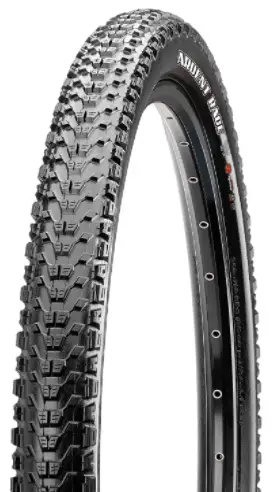Tubular vs Clincher vs Tubeless: three cycling jargons battle it out. You probably never thought you would find yourself having to discuss these things. But when it comes to bicycle tires, it’s important to know the difference. The type of tire you choose not only affects the performance of your bike but how much protection you have on the road.
When you’re new to road biking, tire terminology may seem like a foreign language. As with any sport, the lingo can be difficult to decipher at first. But we aren’t going to leave you out in the cold. We’re going to break down the world of tires for you so you’ll know what kind of tires you need and how to properly ride with them. Once you get a grasp on the basics, you’ll find that it’s not as complicated as it seems.
When it comes to tires for road bikes, there are three main types: tubular, clincher, and tubeless. The latter is not technically a type of tire, but a method of attaching your tire to your bike. Let’s talk about each in a bit more detail.
There is a lot of confusion surrounding tubeless tires, and with good reason. Most people think of clinchers when they think of tubeless tires, but a clincher has tubes while a tubeless tire does not. Tubeless tires are also technically known as tubeless clinchers because they have clincher rims, but many people don’t know that.
Between tubular vs clincher vs tubeless: Let’s start with the traditional one.
1. Clincher Bike Tires
Most bikes are fitted with clincher tires, which have a bead that hooks onto a clincher-style rim. The vast majority of the tire’s rubber surface is in contact with the ground, giving it better traction than other types of tires. Every clincher tire has an inner tube, which you fill with air to keep it from going flat. If your tire gets a hole or puncture, you can easily repair it or replace the inner tube.
For many riders, clincher tires and tubes are the best choices. With high availability, straightforward maintenance, and low prices, they’re a great option for new cyclists or daily commuters on a budget.
Advantages of Clincher Bike Tires
For amateur cyclists and commuters, clinchers are a cost-effective and easy-to-maintain choice of tire. Even if you’re going to take them to your local bike shop, your trained mechanics will not take a lot of time to fix them.
Clinchers are the cheapest option in the tire world, but they are also the most readily available due to their popularity. All-around riders can get high-end clincher tires that are just as good as tubeless and tubular tires but at a higher price. Although it’s not as good as other options in terms of performance, depending on the brand, they can still compete with other types of bike tires.
Clincher bike tires are a great option for those who want to get into cycling, thanks to their stylish design and affordable price. But it’s important that you know how to maintain them properly in order to ensure their longevity.
Clinchers seem to be the way to go. BUT there’s a catch! The battle between Tubular vs Clincher vs Tubeless isn’t over yet!
Disadvantages of Clincher Bike Tires
Although the longevity of a tire depends on factors such as frequency of use and terrain, clinchers are not as durable as tubular and tubeless tires. One reason is that clinchers, which have a separate inner tube to support the tire, can easily be punctured by small debris that gets stuck under the tire (and is therefore difficult to see).
When clincher bike tires suffer from a puncture, they go flat right away. Other bike tires will seem okay even with a blowout, but clinchers won’t: riders may not feel safe on them, nor will they be effective in carrying the rider to their destination.
The Clincher bike tires are known for their higher rolling resistance, due to the fact that their sidewalls are thicker. This leads to less airflow over the tire surface. Combined with the bead found on clincher wheels, this leads to more effort being required on your part in order to move forward.
Although clincher bike tires have disadvantages, this doesn’t mean that you can’t use them at all. Without further ado, have a look at one of the best clincher bike tires on the market.
Continental Gator Hardshell Folding Bike Tire
Check the Latest Price on Amazon.
The Continental Gator Hardshell Folding Bike Tire is one of the best tires available when it comes to road bikes. The durability and versatility that you get with this tire mean that it can handle a lot of different terrains. It is perfect for the city streets, but can also handle smooth paths in the woods.
The Continental Gator Hardshell Folding Bike Tire offers a rare feature that is exclusive to this tire — bead-to-bead Duraskin protection. This feature is what makes the tire so great: it provides excellent ride quality, lower rolling resistance, and durability even with intense use.
The Gator G3 Continental Hardshell Folding Bike Tire is reinforced with the Continental Poly X Breaker which extends across the shoulder of the tire. 180TPI casing works to protect the tire from things like sidewall cuts and grazes, while a great set of rim pads work with this same tread to enhance your stopping power.
Tubular vs Clincher vs Tubeless: Let’s now talk about tubular tires.
2. Tubular Bike Tires
There are a variety of names for tubular tires that circulate in different regions and languages. In the United States, they are often called sew-ups, while in the UK they are also known as tubs. In Australia, some simply call them single tires, as their construction resembles a single layer of fabric rolled into itself.
Tubulars are tires for which the inner tube has been sewn in place. The design of the wheel for tubular tires is specifically tailored to tubular tires — it will not fit clincher tires and vice versa. In order to use tubular tires, you must first prepare them for installation on your bike’s wheels. While there are various ways to do this, the most effective is to glue and tape them into place.
Advantages of Tubular Bike Tires
Tubular tires can stay inflated even when there’s a hole in them because they don’t lose air as quickly as clincher tires, making them much safer than their counterparts.
Tubular tires can stay inflated even when there’s a hole in them because they don’t lose air as quickly as vented clincher tires, making them much safer than their counterparts.
While clincher bike tires have a “hook” on the wheel rim that fits around the tire, tubular bike tires do not have this. Because they lack a hook, tubular bike tires are lighter than their clincher counterparts.
Because, again, tubular bike tires have no hooks that fit into a clincher rim and ALSO have no beads, this discrepancy lends to a superior ride to those of clinchers, which are believed by some to be more “rigid”.
If you use tubular tires for your bike, then it’s likely that you will spend significantly less time getting your tires repaired or replaced, and more time cycling. Since tubular tires don’t have inner tubes, they are much more resistant to getting punctured or damaged — and pinch flats are a thing of the past.
Tubular vs Clincher vs Tubeless: has tubular bike tires won? Not yet! Consider its disadvantages below.
Disadvantages of Tubular Bike Tires
In spite of the fact that tubular bike tires aren’t outrageously expensive, their price is still substantially higher than clincher bike tires.
Tubular tires are an excellent choice for a road bike, but installing them can be difficult. Tubular tires have no bead wire, so they can’t be installed in the same way clincher tires are. However, with the right tools and some know-how, you can still install tubular tires.
When it comes to durability, tubular tires beat clinchers. But tubular tires are also much harder to repair. If you get a flat, you may not be able to fix the puncture yourself, and you might have to take your tire back to the shop to get it repaired.
Tubular tires may have their disadvantages, but there are also a lot of reasons to install them. Check out one of the best tubular bike tires we found online below.
Continental Sprinter Tubular Road Bicycle Tires
Check the Latest Price on Amazon.
This tubular tire is great for city riding, and it’s ideal for anyone who bikes to work every day. It’s just as effective on long commutes as it is on the racetrack. This tire is very light and has an impressive grip. You can attain high speeds with it, and it’s a formidable racing tool.
The Continental Sprinter tire’s sleek curves and aerodynamic design make it a favorite among speed enthusiasts. Coupled with the new ASC Silica rubber compound, your bike will be gliding with ease across the pavement.
Continental builds tires that are up to the challenge of high-speed driving on rugged terrain. Their Sprinter, a light-but-strong tire, offers all the benefits of their other similar high-performance tires: low rolling resistance, high grip, and puncture-resistance. These features make it great for faster driving on road and track alike.
Sporting an anti-puncture breaker belt and Duraskin sidewall protection, this tubular tire will keep your ride on the road for miles — and is a great choice for anyone looking to go the distance.
Okay, I think that’s enough for tubular tires. Tubular vs Clincher vs Tubeless: Why don’t we discuss the last one — tubeless bike tires, shall we?
3. Tubeless Bike Tires
Tire technology should always be at the forefront of cycling innovation, and that’s why tubeless wheels are all the rage right now. Unlike clinchers and tubular tires, tubeless bike tires don’t have a tube inside of them. Inside the tire is a chamber that relies on the tire and rim to keep the tire airtight.
Tubeless bike tires are one of the most innovative products to come out of the cycling industry as of late, with many professional cyclists and cycling enthusiasts heralding them as the future of the sport. With all of this focus on tubeless tires, more and more brands are beginning to manufacture bikes that can accommodate them.
Advantages of Tubeless Bike Tires
Tubeless bike tires roll smoother, quieter, and on lower pressure than their tubular counterparts. Less friction also means lower rolling resistance, which reduces your energy expenditure when riding. The wide range of sizes and models means that tubeless bike tires are perfect for any bike, from mountain bikes to road bikes.
Tubeless tires are lightweight because they don’t require a tube. These tires are also more aerodynamic than tubed tires, making them the best option for professional cyclists.
These tires don’t just keep you safe from punctures. They also have the ability to repair themselves, so if your tire gets a tiny hole in it, all you need is some sealant and that pesky little thing will be fixed up right away!
Tubeless tires have more similarities than differences with their traditional counterparts, clinchers, but there is one key difference: these don’t require glue or tape! So even if you’re a first-timer- it’s easy to install them because no messy gluing required…BUT it’s highly recommended that you get help from a professional when mounting your first tubeless tires.
Before you declare the tubeless as the winner in an all-out Tubular vs Clincher vs Tubeless battle, it’s also important to know its disadvantages. Keep reading!
Disadvantages of Tubeless Bike Tires
Inevitably, even the most well-made bike tires will suffer from a puncture. If the tear is too big to be fixed by sealant alone, you might find yourself in a sticky situation–unless of course, you’ve packed an extra tube along for just that occasion!
It’s also a good idea to keep an emergency kit with you like a portable bike pump and a bike multi-tool. You never know when your tire may get punctured and need some quick patch-up work before the air goes out of them!
Tubeless tires require more precise installation and are more expensive than their traditional counterparts —that’s why most bikers choose to stick with traditional tires. They have a rim of their own, which has been specifically designed for the tire. They are not compatible with standard rims. So if you have a bike with a tubeless-ready rim, the process of installing them will be relatively painless.
Tubes are a thing of the past, and so you may believe that installing tubeless tires is an easy process. This couldn’t be further from the truth because this task can actually get messy for beginners! Applying sealant to your tire also entails many difficulties such as messing up surfaces with sticky residue or having something stinky in your trunk during long road trips. Plus- as if all this wasn’t enough – there’s also the sealant maintenance issue which requires constant care from changing out punctured tubes.
Tubeless bike tires aren’t perfect. They may be expensive, and they may be a hassle to install. But when you see how much better they roll and how incredibly fast you can get them, you’ll never want to go back to regular tires again. Check out one of the best tubeless bike tires you’ll ever find below.
MAXXIS Ardent
Check the Latest Price on Amazon.
The MAXXIS Ardent is a great choice for riders who are looking to go fast. This versatile tire shines on cross-country terrain, where the large tread and lightweight casing accelerate quickly and smoothly over any surface.
This tire comes with several features to enhance its performance. The 60 TPI sidewall construction makes sure that the tire is lightweight and durable. Besides, its carbon fiber and foldable bead enhance the tire’s performance even further.
An abrasion-resistant material coats the sidewalls of this tire to give it extra protection when cornering. It’s perfect for your downhill needs, and will be easy to work on because they’re tubeless-ready!
Conclusion
Finding the right bike tire is difficult. Between tubular vs clincher vs the more modern design like tubeless can make all of the difference in your ride; not to mention there are so many different factors to take into account! Luckily, we here at Volata Cycles have written this article for those looking into making an informed decision without spending too much time doing trial and error themselves- because let’s face it: who has that kind of patience?




